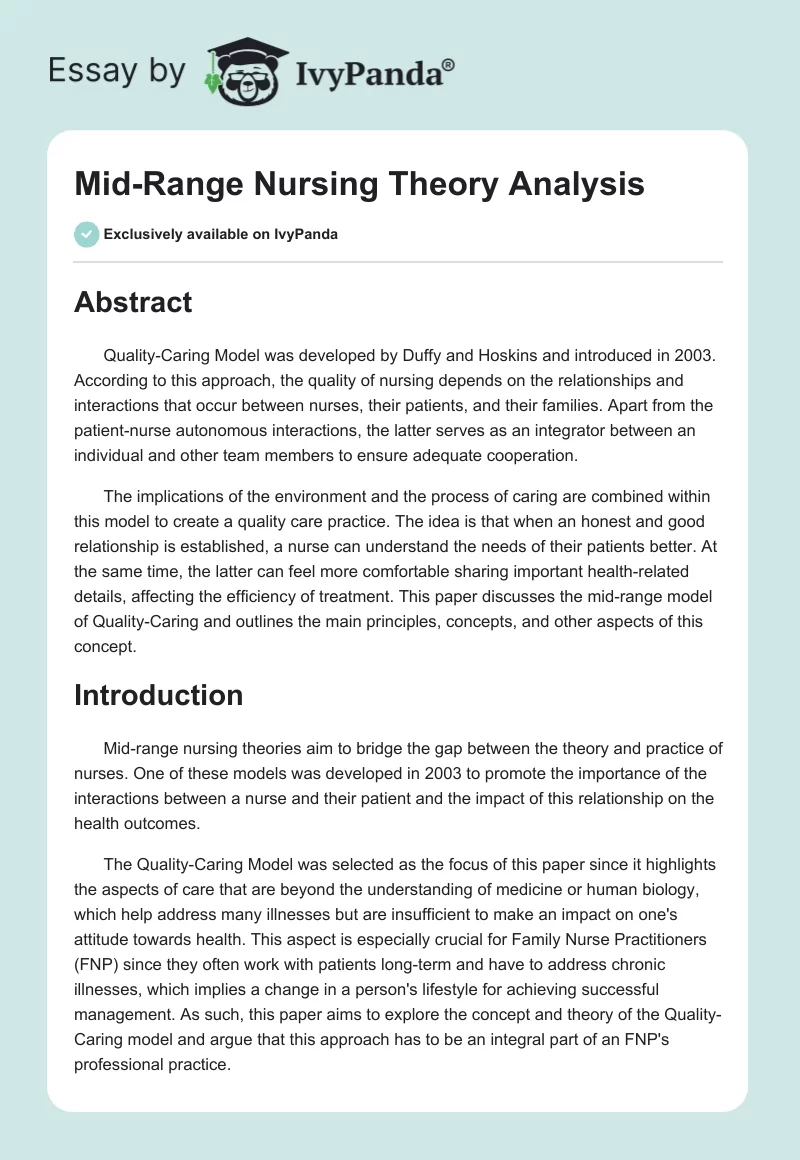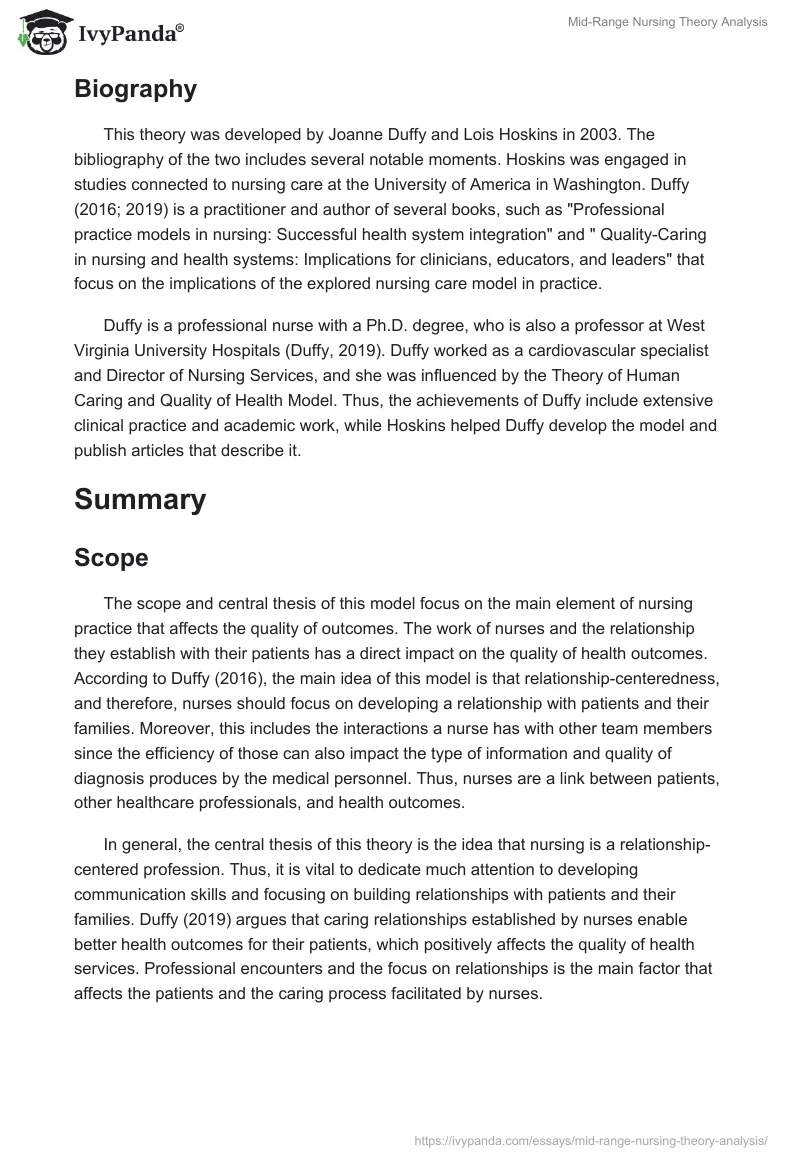Abstract
Quality-Caring Model was developed by Duffy and Hoskins and introduced in 2003. According to this approach, the quality of nursing depends on the relationships and interactions that occur between nurses, their patients, and their families. Apart from the patient-nurse autonomous interactions, the latter serves as an integrator between an individual and other team members to ensure adequate cooperation.
The implications of the environment and the process of caring are combined within this model to create a quality care practice. The idea is that when an honest and good relationship is established, a nurse can understand the needs of their patients better. At the same time, the latter can feel more comfortable sharing important health-related details, affecting the efficiency of treatment. This paper discusses the mid-range model of Quality-Caring and outlines the main principles, concepts, and other aspects of this concept.
Introduction
Mid-range nursing theories aim to bridge the gap between the theory and practice of nurses. One of these models was developed in 2003 to promote the importance of the interactions between a nurse and their patient and the impact of this relationship on the health outcomes.
The Quality-Caring Model was selected as the focus of this paper since it highlights the aspects of care that are beyond the understanding of medicine or human biology, which help address many illnesses but are insufficient to make an impact on one’s attitude towards health. This aspect is especially crucial for Family Nurse Practitioners (FNP) since they often work with patients long-term and have to address chronic illnesses, which implies a change in a person’s lifestyle for achieving successful management. As such, this paper aims to explore the concept and theory of the Quality-Caring model and argue that this approach has to be an integral part of an FNP’s professional practice.
Biography
This theory was developed by Joanne Duffy and Lois Hoskins in 2003. The bibliography of the two includes several notable moments. Hoskins was engaged in studies connected to nursing care at the University of America in Washington. Duffy (2016; 2019) is a practitioner and author of several books, such as “Professional practice models in nursing: Successful health system integration” and ” Quality-Caring in nursing and health systems: Implications for clinicians, educators, and leaders” that focus on the implications of the explored nursing care model in practice.
Duffy is a professional nurse with a Ph.D. degree, who is also a professor at West Virginia University Hospitals (Duffy, 2019). Duffy worked as a cardiovascular specialist and Director of Nursing Services, and she was influenced by the Theory of Human Caring and Quality of Health Model. Thus, the achievements of Duffy include extensive clinical practice and academic work, while Hoskins helped Duffy develop the model and publish articles that describe it.
Summary
Scope
The scope and central thesis of this model focus on the main element of nursing practice that affects the quality of outcomes. The work of nurses and the relationship they establish with their patients has a direct impact on the quality of health outcomes. According to Duffy (2016), the main idea of this model is that relationship-centeredness, and therefore, nurses should focus on developing a relationship with patients and their families. Moreover, this includes the interactions a nurse has with other team members since the efficiency of those can also impact the type of information and quality of diagnosis produces by the medical personnel. Thus, nurses are a link between patients, other healthcare professionals, and health outcomes.
In general, the central thesis of this theory is the idea that nursing is a relationship-centered profession. Thus, it is vital to dedicate much attention to developing communication skills and focusing on building relationships with patients and their families. Duffy (2019) argues that caring relationships established by nurses enable better health outcomes for their patients, which positively affects the quality of health services. Professional encounters and the focus on relationships is the main factor that affects the patients and the caring process facilitated by nurses.
Context
The central meta paradigm concept of this model is the environment that affects a patient and their health and can be affected through communication. Duffy (2019) states that “relationships are the context of human birth, living, working…” (p. 67). The idea is that when a person feels cared for and is in a trustworthy relationship with the healthcare provider, they can feel more comfortable when sharing details about their condition, symptoms, and other health-related factors, which otherwise can be missed. Moreover, Duffy (2019) argues that such people are more inclined to follow the recommendations of medical professionals.
It is significant because the provision of health services is a complicated matter that involves not only efforts from medical professionals, such as nurses, availability of resources and variety of treatment options but also the willingness of a person to rely on the advice of their provider (Duffy, 2019). This enables the change of old patterns of behavior that possibly led to the development of a condition and successful management of the disease.
Patients should be regarded as complex beings whose health is affected by multidimensional factors. More specifically, people are interconnected with other individuals, including healthcare professionals, and their health is a result of these interactions (Duffy, 2016).
The other meta paradigms of nursing focus on a person, health, and nursing. From a nursing meta paradigm perspective, this model leverages the care provided by these medical professionals and addresses the idea that relationships facilitated by nurses and the safe environment created by them are crucial (Duffy, 2016). From the perspective of health, the model suggests that effective communication, such as cooperation with teams, can affect the outcomes of treatment. From a person’s perspective, this model leverages the main elements of this metaparadigm – patient and their families. According to the Quality-Caring approach, a nurse should communicate with an individual and their family members.
Content
The unique concepts that are a part of the Quality-Caring Model include the focus on the relationship between a patient and a nurse, as a basis of healthcare quality. This approach suggests that focusing on trust, mutual respect, and ensuring sensitivity to needs are essential for adequate caring (Duffy, 2019). The primary principle of this model is the uniqueness of each patient case. Based on this model, health is viewed as a dynamic structure, dependant on the context and setting. Therefore, nurses can have a direct impact on the quality of outcomes by addressing the environment, cooperation, and caring attitudes.
The model urges nurses to work on the environment in which their patients receive healthcare services, to create a caring atmosphere that will help improve outcomes of treatment. Duffy (2019) states that relationships are the core element of this environment because they enable nurses to understand the needs of their patients better. In the context of the environment, this includes everything that a patient sees and encounters over the course of treatment in a healthcare facility. Thus, the unique concepts of this model are the approach to nursing that emphasizes professional relationships.
Applicability
Setting
This research paper focuses mainly on the implications of the Quality-Caring Model for the work of FNP. However, there are examples from other fields that highlight the beneficial impact of this model on a patient’s well-being. One of them is empirical research by Compton et al. (2018) in which the authors assess and evaluate the perception of patients regarding nurses’ attitudes and the impact of the nurse-patient relationship on their health upon discharge. The findings suggest that care displayed by nurses is an essential indicator of quality.
The selected setting, in which the Quality-Caring Model will be applied, is the daily practice of an FNP who often encounters individuals with chronic illnesses, which require ongoing monitoring and education regarding the management of their illness to ensure a sufficient quality of life. According to Compton et al. (2019), “mutual problem solving might be an appropriate area for nurses to focus on” (p. 1680).
According to the examined model, this is an essential factor since it encourages nurses to interact with patients and their families, confront issues, and find suitable resolutions to problems that patients may encounter. Another implication is the need to assess how a specific patient perceives caring behavior, since the approach to caring may be different for people. This is also achieved through communication with patients and the establishment of a relationship.
Nursing Practice
In the nursing situation, where an FNP provides healthcare services to individuals continuously, the Quality-Caring Model is essential. This is supported by the evidence from Compton et al. (2019) that suggests that patients value the care provided by a nurse, and it affects their perception of the quality of services. Apart from formally assessing the illness history or a given patient, a nurse should engage in a conversation about health and illness to fully understand the perception of this individual.
In relation to chronic conditions, by establishing a relationship with patients and their families, a nurse can gain a better comprehension of the management practices an individual uses. For example, they can ask and receive an honest answer about diet and exercising routings from patients who have diabetes, which can be an issue if an individual feels shame regarding their habits. However, in accordance with the Quality-Caring Model, a nurse can provide better care by having a complete understanding of an individual’s health state.
Feasibility
Similar to any other nursing theory, the Quality-Care Model has several limitations and weaknesses that can obstruct one from applying it in practice and must be discussed to use it in nursing successfully. Mainly, it requires an investment of time-based resources and money (Utley, 2017). This is connected to a need to educate all professionals working in a given hospital, for example, all nursing personnel, to ensure that adequate communication across different teams can be established in accordance with this model. Therefore, the main problem that can be anticipated as part of the implementation of Quality-Care Model is that other care providers must be involved in the process of implementing its principles.
However, the theory is not too complicated since it is connected to all aspects of the nursing meta paradigms. The Quality-Care Model can contribute to healthcare by promoting an establishment of cooperation between nurses and their patients. For example, the two parties will be able to work on the management of chronic conditions more effectively, by cooperating and communicating clearly to define any obstacles or issues.
References
Compton, E., Gildemeyer, K., Mason, T., Hartranft, S., & Sutton, S. (2018). Nurses’ caring behaviors: The perception of patients with cancer at the time of discharge after surgery. Clinical Journal of Oncology Nursing, 22(2), 169–174. Web.
Compton, E., Gildemeyer, K., Reich, R., & Mason, T. (2019). Perceptions of caring behaviours: A comparison of surgical oncology nurses and patients. Journal of Clinical Nursing, 28(9-10), 1680-1684. Web.
Duffy, J. R. (2016). Professional practice models in nursing: Successful health system integration. Springer Publishing Company.
Duffy, J. R. (2018). Quality caring in nursing and health systems: Implications for clinicians, educators, and leaders (2nd ed.). Springer Publishing Company.
Utley, R. A. (2017). Care and caring frameworks. In K. Henry, L. Smith, & R. A. Utley (Eds.), Frameworks for advanced nursing practice and research: Philosophies, theories, models, and taxonomies (pp. 57-90). Springer Publishing Company.


